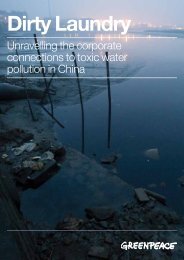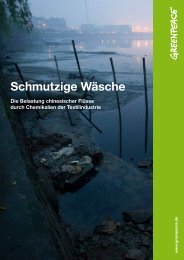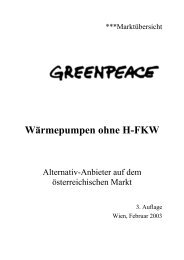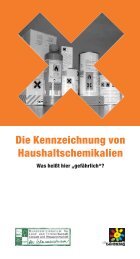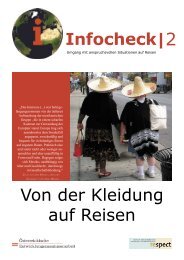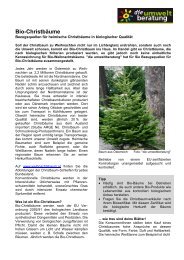Die Schwarze Liste der Pestizide - Greenpeace
Die Schwarze Liste der Pestizide - Greenpeace
Die Schwarze Liste der Pestizide - Greenpeace
Erfolgreiche ePaper selbst erstellen
Machen Sie aus Ihren PDF Publikationen ein blätterbares Flipbook mit unserer einzigartigen Google optimierten e-Paper Software.
<strong>Greenpeace</strong> e.V. – <strong>Die</strong> <strong>Schwarze</strong> <strong>Liste</strong> <strong>der</strong> <strong>Pestizide</strong><br />
In this case, the narrative includes a summary of both the experimental and epidemiologic information on<br />
mode of action and also an indication of the relative weight that each source of information carries, e.g.,<br />
based on human information, based on limited human and extensive animal experiments.<br />
Likely to be carcinogenic to humans. This descriptor is appropriate when the weight of the evidence is adequate to<br />
demonstrate carcinogenic potential to humans but does not reach the weight of evidence for the descriptor “Carcinogenic<br />
to Humans.” Adequate evidence consistent with this descriptor covers a broad spectrum. As stated previously, the use of<br />
the term “likely”as a weight of evidence descriptor does not correspond to a quantifiable probability. The examples below<br />
are meant to represent the broad range of data combinations that are covered by this descriptor; they are illustrative and<br />
provide neither a checklist nor a limitation for the data that might support use of this descriptor. Moreover, additional<br />
information, e.g., on mode of action, might change the choice of descriptor for the illustrated examples. Supporting data<br />
for this descriptor may include:<br />
an agent demonstrating a plausible (but not definitively causal) association between human exposure and<br />
cancer, in most cases with some supporting biological, experimental evidence, though not necessarily<br />
carcinogenicity data from animal experiments;<br />
an agent that has tested positive in animal experiments in more than one species, sex, strain, site, or exposure<br />
route, with or without evidence of carcinogenicity in humans;<br />
a positive tumor study that raises additional biological concerns beyond that of a statistically significant result,<br />
for example, a high degree of malignancy, or an early age at onset;<br />
a rare animal tumor response in a single experiment that is assumed to be relevant to humans; or<br />
a positive tumor study that is strengthened by other lines of evidence, for example, either plausible (but not<br />
definitively causal) association between human exposure and cancer or evidence that the agent or an important<br />
metabolite causes events generally known to be associated with tumor formation (such as DNA reactivity or effects<br />
on cell growth control) likely to be related to the tumor response in this case.<br />
Suggestive evidence of carcinogenic potential. This descriptor of the database is appropriate when the weight of<br />
evidence is suggestive of carcinogenicity; a concern for potential carcinogenic effects in humans is raised, but the data<br />
are judged not sufficient for a stronger conclusion. This descriptor covers a spectrum of evidence associated with varying<br />
levels of concern for carcinogenicity, ranging from a positive cancer result in the only study on an agent to a single<br />
positive cancer result in an extensive database that includes negative studies in other species. Depending on the extent<br />
of the database, additional studies may or may not provide further insights. Some examples include:<br />
a small, and possibly not statistically significant, increase in tumor incidence observed in a single animal or<br />
human study that does not reach the weight of evidence for the descriptor "Likely to Be Carcinogenic to Humans."<br />
The study generally would not be contradicted by other studies of equal quality in the same population group or<br />
experimental system (see discussions of conflicting evidence and differing results, below);<br />
a small increase in a tumor with a high background rate in that sex and strain, when there is some but<br />
insufficient evidence that the observed tumors may be due to intrinsic factors that cause background tumors and<br />
not due to the agent being assessed. (When there is a high background rate of a specific tumor in animals of a<br />
particular sex and strain, then there may be biological factors operating independently of the agent being assessed<br />
that could be responsible for the development of the observed tumors.) In this case, the reasons for determining<br />
that the tumors are not due to the agent are explained;<br />
Seite 149 von 166




